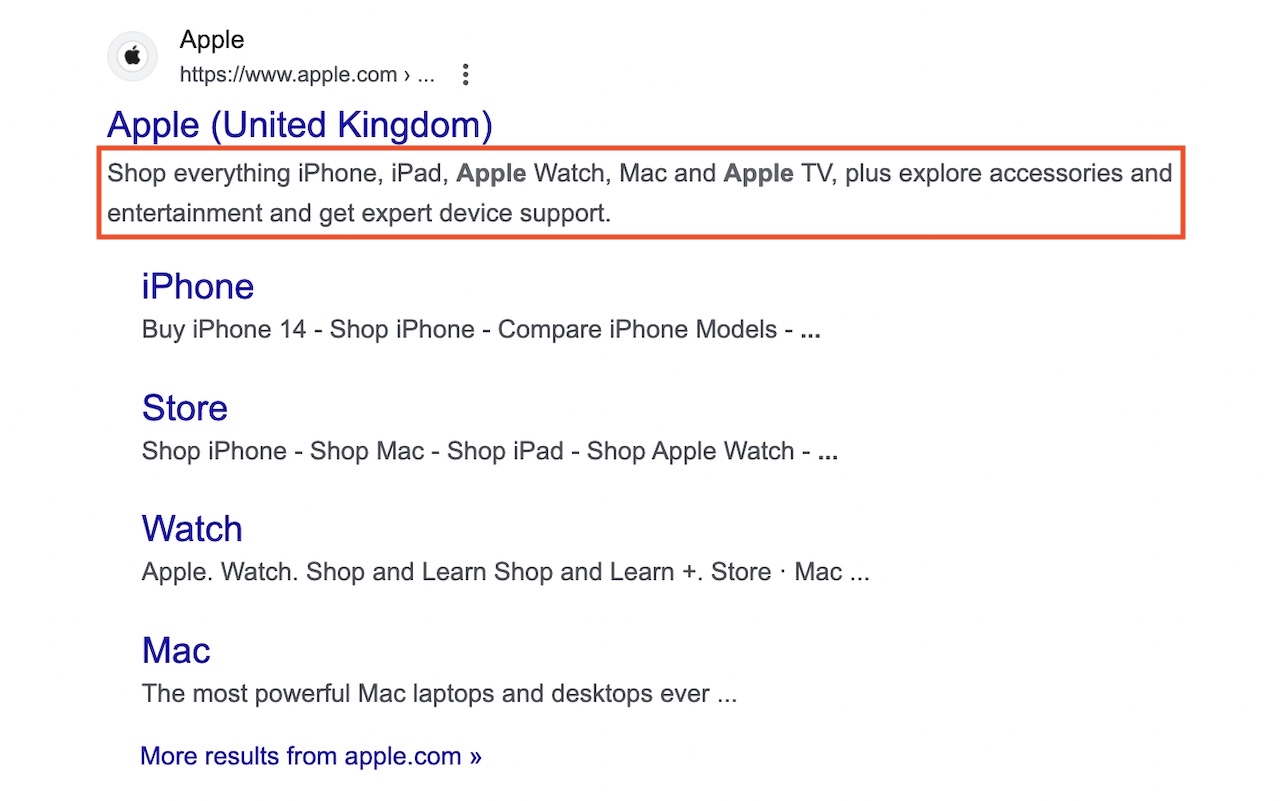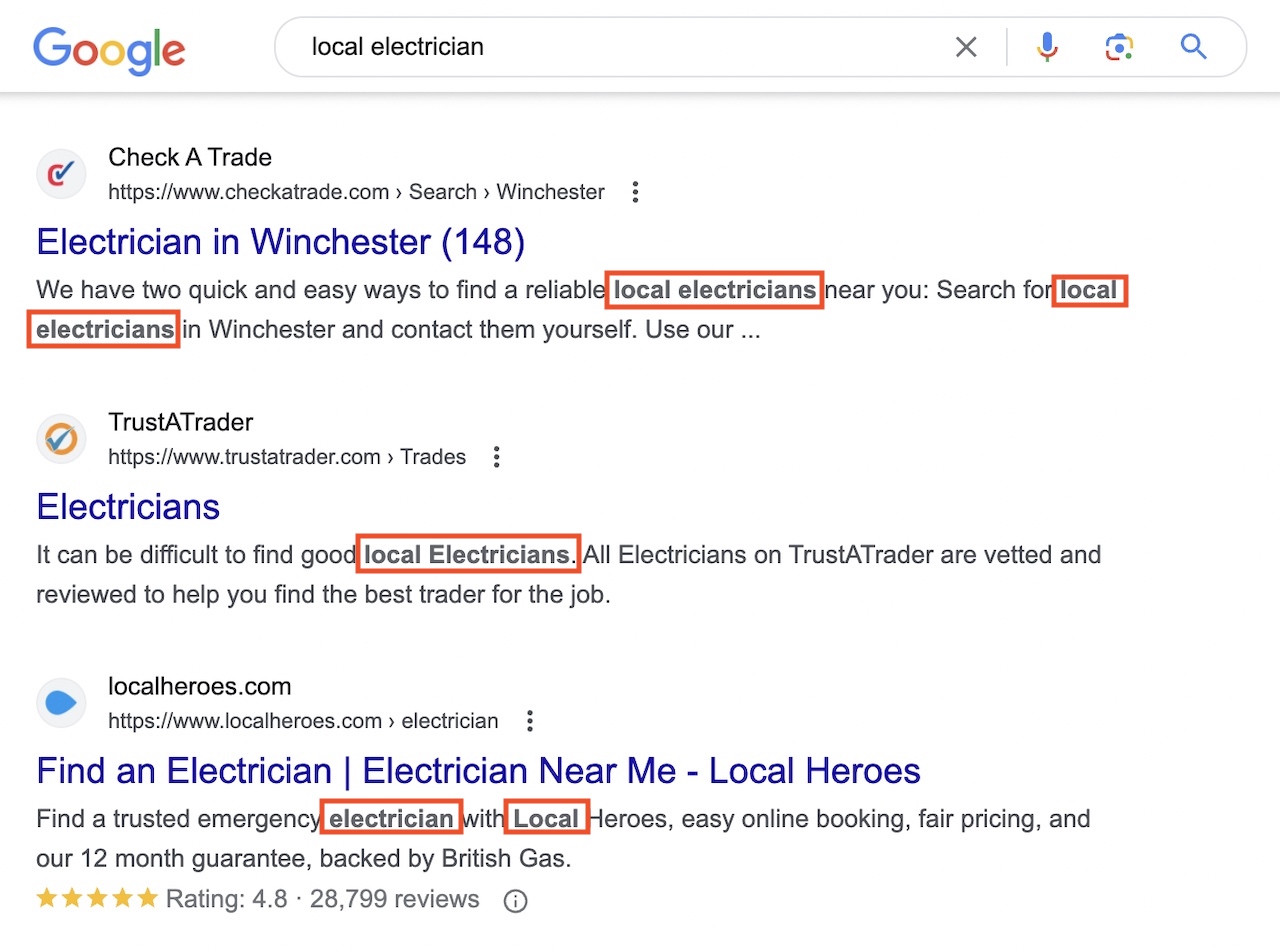Page Meta Descriptions: Beginners Guide To Writing Meta Descriptions
What are Page Meta Descriptions?
Page meta descriptions, often referred to simply as meta descriptions, are brief and concise snippets of text that provide a summary of the content of a web page. They are part of the HTML code of a webpage and are typically included in the <head> section. Most CMS platforms or SEO plugins have a field where you can update and edit your meta description for pages or posts.
Why Are Meta Descriptions Important?
Meta descriptions are important for several reasons when it comes to SEO, and although not considered by Google to be a direct ranking factor, they can have an indirect effect on your page rankings.
Increase Page Click-Through Rates (CTRs)
In the Google search engine results pages (SERPs), the grey text underneath the blue titled link is the meta description. This text is generally the second thing a searcher reads when scanning through the SERPs to decide what website to visit. Because it influences the searcher’s decision, a well-written meta description can actually boost and increase rankings indirectly by increasing the click-through rate of the SERP.
In other words, your meta description acts as “organic ad text” because it’s a mini ad to sell the searcher on the page they are about to visit. The more compelling it is, the more likely the searcher will click on that result and visit the page.
Meta Description Examples
Below are a few different examples of how meta descriptions look across various platforms:
HTML Code Example
When you view the source code of a web page, you’ll be able to see the meta description as the below code, for example, on apple.com:

SERP Example
In the Google search engine results pages (SERPs), you’ll see the meta description as the grey text underneath the blue title:
In the Google search engine results pages (SERPs), you’ll see the meta description as the grey text underneath the blue title, for example, on apple.com:

Social Shares Example
On many social network platforms, the meta description is automatically pulled into the post snippet to provide relevant information about the page, for example, on apple.com:

How To Write a Good Meta Description
Meta description writing is both an art and a science, so below we’ve outlined some of the best practices and tips in which you can ensure your meta description gets the most clicks in the SERPs:
Write Compelling Advertising Copy
Craft a meta description that entices users by highlighting the most attractive and relevant aspects of your content or business, making it irresistible to click on. By using power words - words that evoke emotions - you can more easily trigger a click from the user.
Avoid Duplications; Make It Unique
Ensure that each meta description across your website is unique and tailored to the specific content or page it represents. Duplicate meta descriptions can be confusing to both users and search engines. When there’s confusion, then no actions are taken and your click-through rate, traffic, and rankings decrease.
Length of Meta Descriptions
Keep your meta descriptions concise and within the recommended limit of around 155-160 characters to ensure they display fully in search results, providing enough information without being too long. If they are longer than this length, they are likely to be truncated (the endings cut off), which loses critical information about the content.
Make It Actionable
Encourage user engagement by including actionable language in your meta description. For example, use phrases like "Learn how to," "Discover," or "Find out more" to prompt users to take action. This language can lead to higher click-through rates, and subsequently, possibly higher rankings.
Include a Call To Action
Add a clear and concise call to action (CTA) to guide users on what to do next, such as "Shop now," "Request a quote," or "Read our latest blog post." A well-placed CTA can boost click-through rates, and also increase conversions & sales on the website.
Use Your Primary Keyword
Incorporate your primary keyword naturally within the meta description, ideally as close to the beginning of the meta description as possible. This can improve the relevance of your meta description to the user's search query and is usually bolded by search engines. The bolded keywords help users to easily scan pages for relevancy and find pages that fit their intent.
Below you'll see "local electrician", "local", and "electrician" keywords bolded in the meta descriptions within the SERPs:

Match the Content on the Page
Ensure that the content on the page aligns with the promises made in the meta description. A meta description should accurately represent what users will find when they click through to the page, enhancing user satisfaction and trust.
Why Doesn’t Google Use My Meta Description?
A common question that is asked by businesses and website owners is does Google rewrite meta descriptions? The answer is yes. Google will automatically rewrite some of your website’s meta descriptions if it feels that it more accurately reflect the content on that page.
This can be annoying to some, who just want to display what they wrote, so the next logical question is how to decrease this possibility as much as possible.
Kim Herrington, an SEO and SEM consultant, has discovered that when e-commerce stores focus on high-traffic keywords, there is a greater likelihood that their original meta descriptions will appear as intended on their websites.
This means that there is a way to control this to a certain extent, but don’t be surprised or frustrated if Google does rewrite your meta descriptions. It’s always better to write them and then let Google decide if it feels it needs to be rewritten or not, rather than not writing them at all.
Using AI to Generate Meta Descriptions
Writing meta descriptions can be time-consuming, so leveraging AI to write them for you, or at least provide a starting point for you can save a lot of time.
The key is not to necessarily copy/paste the first response and use that as your meta description. Instead, leverage it as a potential starting point or idea and then refine it to be even more better.
Hike + Meta Descriptions
When it comes to meta descriptions, Hike can help you research keywords that you can map to specific pages that you’ll be able to use within your meta description when you go to write them. Additionally, Hike’s AI Content Wizard generates a draft blog article around that topic as a starting point to save you time and gives you a head-start to creating SEO-friendly content.
If you haven’t yet tried Hike, sign up today and see how easy it is to become empowered to take control of your SEO.